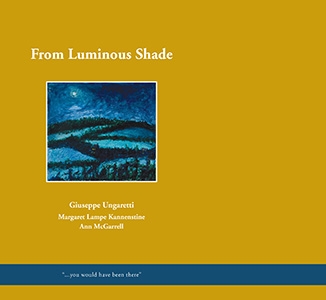 (Host) Commentator Tom Slayton is a long time journalist and observer of
(Host) Commentator Tom Slayton is a long time journalist and observer of
all things Vermont, who recently attended a gallery exhibit featuring
the work of two Vermont artists who collaborated on a project reflecting
their personal journeys from loss to acceptance – from darkness to
light.
(Slayton) Grief for a lost child takes as many forms as there are grieving parents. Not long ago, to create a memorial for the children they lost, artist Peggy Kannenstine and translator Ann McGarrell turned to what they know and do best: their work.
The result is a small, elegant book entitled From Luminous Shade, which includes poems of grief by the Italian poet Giuseppi Ungaretti, translated into English by McGarrell, and illustrated by Kannenstine’s paintings. There’s also a current exhibit of the paintings and beautifully printed letterpress versions of the translations at Medical Center of Vermont in Burlington.
Ungaretti’s series of poems, Il Dolore, was written upon the death of his son in the 1940s. Kannenstine’s son David died of pancreatic cancer in 2009; McGarrell’s son Flo was killed in the Haiti earthquake of January 2010. The universal experiences of death and grief unite the poem, its translation, and the paintings.
 As David weakened and eventually died, Kannenstine expressed her grief by picking up her paints and brushes and creating a series of paintings – not of him, but of the world around her – landscapes and still life compositions. Shortly after David’s death, when McGarrell was visiting Kannenstine, she walked into the artist’s studio, saw the paintings and said, “Oh – Ungaretti!”
As David weakened and eventually died, Kannenstine expressed her grief by picking up her paints and brushes and creating a series of paintings – not of him, but of the world around her – landscapes and still life compositions. Shortly after David’s death, when McGarrell was visiting Kannenstine, she walked into the artist’s studio, saw the paintings and said, “Oh – Ungaretti!”
McGarrell sent Kannenstine her translation of Ungaretti’s poems of grief, and the two realized that they had the seeds of a collaboration. Then, a short while after the collaboration had begun, it took on a much deeper meaning: McGarrell’s son had died in the Haiti earthquake.
To view the paintings and read the poems is to take a deep journey with artist, poet, and translator, through dread, anguish and sorrow – to resolution and, eventually, acceptance.
“How can I bear the weight of so much night?” the poet asks. “I love you, love you; and I go on, shattered.”
In a similar vein, Kannenstine’s images translate that emotion into a series of landscapes that begin in darkness – deep moonlit hillsides, a sun setting behind a looming, silhouetted mountain – and move gradually toward light – a bright, sunny meadow, flowers, and, most significantly, blooming apple trees – which Kannenstine painted as a tribute to her son’s work for an upstate New York apple orchard.
 In the lyrical pink and green flourishes of the apple blossoms in Apple Song, one can feel the love the artist had – and has – for her lost son.
In the lyrical pink and green flourishes of the apple blossoms in Apple Song, one can feel the love the artist had – and has – for her lost son.
Why did she choose to paint landscapes, both dark and light, while her son lay dying? “I’m just so connected to the landscape around me,” Kannenstine said, noting that even in the darkest paintings there are still flashes and spots of light.
“You hold onto that light,” she said. “Knowing that no matter how dark it gets, life does go on….”